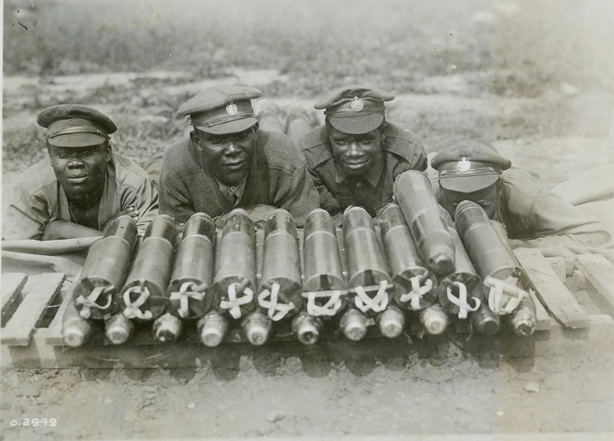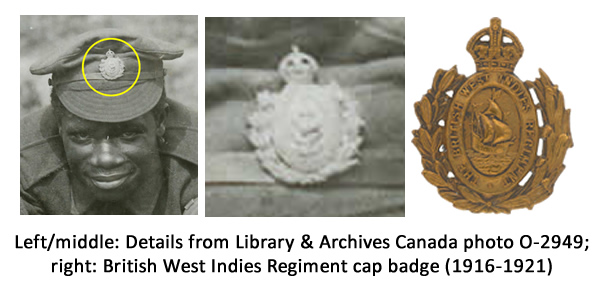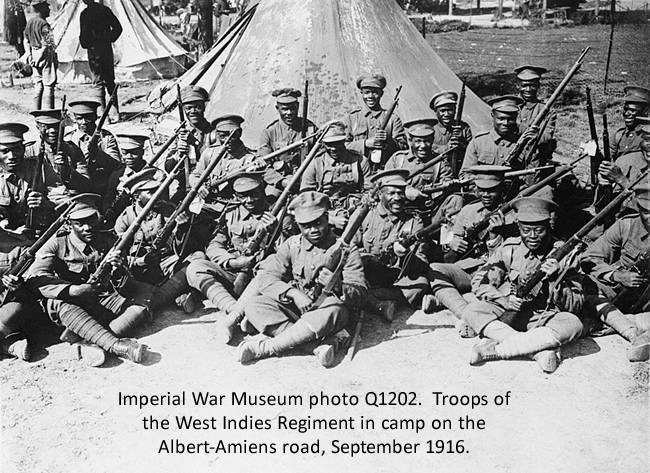
Official photo description: Three black soldiers in a German dug-out captured during the Canadian advance east of Arras (France). October 1918. Library & Archives Canada photograph PA-003201. [1] Photographer (Lieutenant) William Rider-Rider. Colorized version ©Vimy Foundation, Canada. Photo VF4-9 [2]
PARTING SHOT: A Photograph Worth At Least 500 Words
Like so many of the photographs from the Great War (1914-1919), this one begs for more details from the official description.
What is going on in this photo?
We have three soldiers jokingly pretending to “surrender” to the unseen photographer. The men are standing in a ‘dugout’, an underground shelter used for rest quarters in a support trench, usually near the front lines. Only their heads and shoulders are visible.
Collectors of militaria will quickly identify the helmet and ammunition pouches strewn about the entrance as German military gear, as well as personal items (clothing, slippers and cookstove) indicating that this German dugout has already been searched and pillaged of anything interesting or valuable. The only weapon visible is on the edge of the dugout, a muddy Gewehr 98 rifle, a standard-issue infantry weapon of Imperial Germany. [3]
None of the soldiers are armed, nor are there any tools or supplies visible. The pattern of their helmets and uniforms identifies them as British Empire. All three soldiers are Black.
Who are these men?
How often do you see pictures from the First World War of Black soldiers? The official record notes that these soldiers are in the Canadian sector, 1917, near the front lines. The Canadian war photographer offered no information about which unit these men belonged to. Fortunately, one of the soldiers in the photograph has offered to help us figure that out. He’s the one wearing the cap badge.
Cap Badges and Shoulder Titles
Beginning around the 1880’s (about the same time the first Lee-Enfields were introduced into service) the British Empire adopted shoulder titles, a metal insignia that indicated the wearer’s unit. [4] By 1900 virtually all units were wearing some type of metal shoulder title. In addition, cap badges were distinctive emblems that were unit specific. Uniform buttons might also sport the regimental crest.
The Canadian Expeditionary Force (CEF) [5] was no exception. Each unit had their own distinctive emblem, although for many, a collection of CEF cap badges might look like five hundred variations of the maple leaf pattern, with a few moose and beaver thrown in.
Pioneer Battalions in the CEF
Operationally, soldiers are divided into two distinct groups – combat units and support units. While the combat arms get the attention, it is the support units – the builders of roads, bridges and railroads, the transport and supply units, the cooks, electricians, plumbers, veterinarians, carpenters, mechanics and armourers that make the combat arms possible.
There are engineering battalions, service corps, sappers and miners, transport corps, the medical and ambulance corps – the names are as varied as their function. The Canadians had pioneer battalions and forestry battalions. For a variety of reasons, men of color in England, Canada, Australia, South Africa and New Zealand who wanted to serve King and Country often found themselves routed into non-combat roles in segregated service/support units.
Back to the photograph. Black men. Western Front. Canadian sector. 1917. Not carrying weapons. My first thought was “pioneer battalion”. A quick search for ‘black soldiers-canada-wwi’ quickly lead to Canada’s No.2 Construction Battalion, first raised in Truro, Nova Scotia in 1916 and sent to France in March 1917. [6] Upon arrival they were sent to the French-Swiss border as part of the Canadian Forestry Corps to produce timber. Although they asked to be transferred to the Western Front (April 1918), nothing came of it. [7]
Additional research shows that the cap badge of the No.2 Construction Battalion is noticeably different from the one we’re looking for. Conclusion: the men in the photo are not from Canada’s No.2 Construction Battalion.

Any lingering hopes for a one-Canadian-cap-badge search died when I later read that “In addition to the men of the Black Battalion, an estimated 2,000 Black Canadians… were determined to get to the front lines and managed to join regular units, going on to give distinguished service that earned some of them medals for bravery.” [8]
Black men. Western Front. Canadian sector. 1917. The official description does not state that the men are Canadian. If the soldiers are not Canadians, this expands our cap badge search to more than 2000 Great War era cap badges to consider.
Knowing next-to-nothing about cap badges, it was time to look for help. I was fortunate to find Mike McMahon’s website, Arctic Metals and Militaria. [9] Mr. McMahon graciously took to the time to help, pointing out that none of the men in the photo were wearing Canadian shoulder titles, and that what we could see of the cap badge resembled the badge of the British West Indies Regiment, [10] a twelve battalion regiment (about 15,000 men) of black troops that served in combat and support roles on the Western Front, as well as Palestine, Egypt and Italy.
I wasn’t quite ready to completely rule out the Canadian connection, so I looked for additional photographs of black soldiers in several Canadian archives, finding several of the No. 2 Construction Battalion. [11] I also found this interesting photograph:

Library and Archives Canada photo O-2949. Photographer unknown. The official description (in part) reads “(Black men)…who with others, load Canadian Corps Tramways with ammunition, resting. July, 1918.” [12]
Again, the official description does not state that the men are Canadian. A close look at their cap badges shows a strong resemblance to the British West Indies Regiment badge. [13]

So when all is said and done, we do know a little more than we started. That with few exceptions, Canadian black men who volunteered to serve King and Country were routed to non-combat roles and the No. 2 Construction Battalion. And that the British West Indies Regiment, an all-volunteer Caribbean regiment of men from Jamaica, British Honduras, the Bahamas, Barbados, Trinidad, Grenada, British Guiana, Tobago, St Lucia and St Vincent contributed a significant – and often overlooked – combat role on the Western Front, as well as Palestine and Jordan.
So, back to our original question: who are these men in the colorized photograph? Are they from a Canadian unit? Or are they from the British West Indies Regiment? Or are they from another unnamed regiment? One hundred years after the photograph was taken, it's your call.

Photo notes: Imperial War Museum photo Q1202. Troops of the West Indies Regiment in camp on the Albert - Amiens road, September 1916. Photographer Brooks, Ernest (Lieutenant). [14]
Parting Shot: A Photograph Worth At Least 500 1077* Words
*(1452 if you include the footnotes).
Page Notes & Sources
[1] Library and Archives Canada Item 3194350; Photo PA-003201. http://central.bac-lac.gc.ca/.redirect?app=fonandcol&id=3194350&lang=eng
[2] Colorized version of PA-003201 ©Vimy Foundation, Canada. Used with permission.
The Vimy Foundation https://www.vimyfoundation.ca/about/mission/ “works to preserve and promote Canada’s ongoing legacy of leadership as symbolised by the First World War victory at Vimy Ridge in April 1917, a milestone where Canada came of age and was recognised on the world stage.”
The First World War in Colour https://www.vimyfoundation.ca/projects/ “project will consist of colourizing 150 images from Library and Archives Canada as well as local archives from across the country. These photographs will help commemorate both the 100th anniversary of the end of the First World War and the 150th anniversary of Canada’s Confederation.”
[3] Wikipedia: Gewehr 98 https://en.wikipedia.org/wiki/Gewehr_98
[4] Westlake, Ray. Collecting Metal Shoulder Titles, 2nd Edition, 1996, Pen and Sword Books, ISBN 0-85052-524-1; Page 01
[5] Wikipedia: Canadian Expeditionary Force (1914-1919) https://en.wikipedia.org/wiki/Canadian_ExpediCombattionary_Force
[6] Wikipedia: No.2 Construction Battalion https://en.wikipedia.org/wiki/No._2_Construction_Battalion
[7] Hunt, M.S.; Nova Scotia's Part in the Great War. The Nova Scotia Veteran Publishing Company Limited. 1920, pp. 148–153.
All 458 pages of Nova Scotia's Part in the Great War are available on-line (found here: https://archive.org/stream/novascotia00huntuoft#page/148/mode/2up ) and easily accessible in a variety of formats (including Kindle), thanks to McMaster University (Toronto, Canada) and the Internet Archive, https://archive.org/about/ a free library.
[8] Veterans Affairs Canada, Black Canadians in Uniform https://www.veterans.gc.ca/eng/remembrance/those-who-served/black-canadians-in-uniform/history
[9] Website: Arctic Metals and Militaria: https://www.arcticmedals.com/page/page/3727538.htm
[10] Wikipedia: British West Indies Regiment: https://en.wikipedia.org/wiki/British_West_Indies_Regiment
[11] Photo collection of No.2 Construction Battalion: Globe and Mail (Canada) article published 09 November 2018; Black on the Battlefield: Canada’s Forgotten First World War battalion; https://www.theglobeandmail.com/canada/article-black-on-the-battlefield-canadas-forgotten-first-world-war-battalion/ (Retrieved December 2020)
[12] Library and Archives Canada: http://central.bac-lac.gc.ca/.redirect?app=fonandcol&id=3396814&lang=eng
[13] Cap badge, British West Indies Regiment, 1916-1921; image courtesy National Army Museum collection; Image number: 156476; https://collection.nam.ac.uk/detail.php?acc=1967-05-32-3
[14] Imperial War Museum; Collection “Battle of the Somme, July-November 1916” https://www.iwm.org.uk/collections/item/object/205124467
Additional reading: Imperial War Museum: British West Indies Regiment in the First World War https://www.iwm.org.uk/history/the-story-of-the-british-west-indies-regiment-in-the-first-world-war